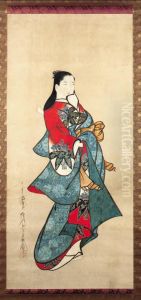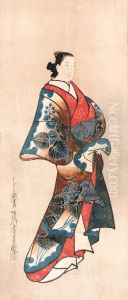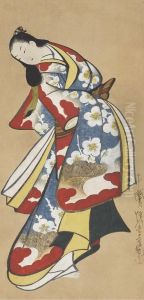Kaigetsudo Doshin Paintings
Kaigetsudō Doshin was a Japanese painter and print designer who lived during the Edo period. His exact birth date is not known, and much of his life remains shrouded in mystery. Doshin is most renowned as a member of the Kaigetsudō school, a group of artists who were active in the early 18th century and are best known for their bijinga (pictures of beautiful women).
The founder of the Kaigetsudō school was Kaigetsudō Ando, and it is believed that Doshin was one of his pupils, alongside other artists such as Kaigetsudō Anchi and Kaigetsudō Dohan. The school is named after the studio near the Benten Shrine in the Asakusa district of Edo (present-day Tokyo), where Ando and his followers worked.
Doshin's works, like those of the Kaigetsudō school, are characterized by their bold, curvilinear outlines and the use of vibrant colors. His paintings and prints often depicted courtesans from the Yoshiwara pleasure district, portrayed in a stylized and idealized manner. The figures in his compositions are typically seen in full-length portraits, with an emphasis on their elegant kimono and fashionable hairstyles.
Notably, the Kaigetsudō artists were among the first in Japan to produce single-sheet ukiyo-e prints, which were more affordable than paintings and could be mass-produced. This innovation helped to popularize the ukiyo-e genre, which focused on the 'floating world' of Edo's pleasure districts, theaters, and teahouses.
Doshin's career came to an abrupt end when, in 1714, members of the Kaigetsudō school, including Ando, were exiled or imprisoned due to involvement in a scandal. While the exact nature of the scandal remains unclear, it involved the shogunate and was a significant event that led to the dispersal of the school. However, Doshin's date of death is recorded as 1747, suggesting that he may have continued his work after the incident, albeit likely under constraints or in a diminished capacity.
Today, Kaigetsudō Doshin's prints and paintings are valued for their artistic merit and historical significance. They provide insights into the culture of the Edo period and the development of the ukiyo-e tradition. His works are held in various museums and collections around the world, where they continue to be studied and appreciated by art enthusiasts and scholars alike.

![Courtesan
Bearing Signature Nihon Giga Kaigetsu Matsuyo Doshin Zu Kore [o] Zu[su], Sealed Ando](https://www.niceartgallery.com/imgs/546482/s/kaigetsudo-doshin-courtesan-bearing-signature-nihon-giga-kaigetsu-matsuyo-doshin-zu-kore-o-zusu-sealed-ando-d99d3bd4.jpg)

